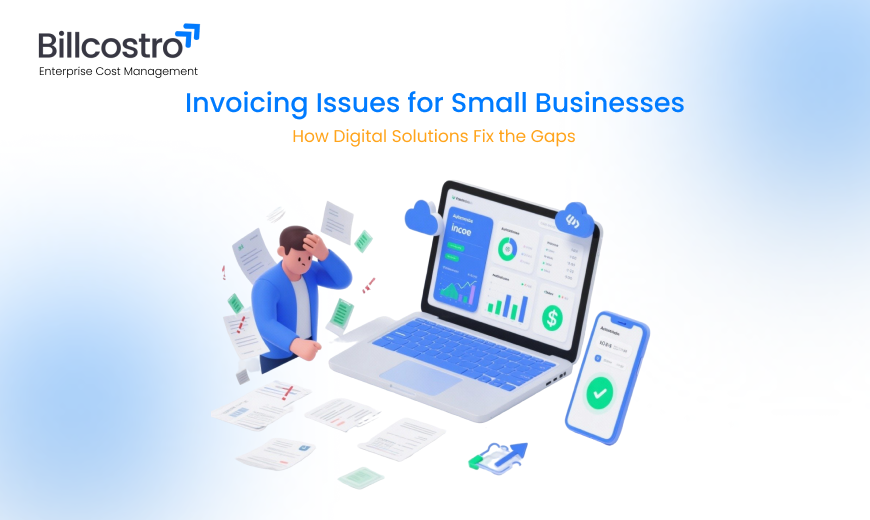
Sept. 16, 2025, 6:18 a.m.

For small businesses, invoicing is more than just a receipt of payment; it is a way to maintain a healthy cash flow cycle, ensure the company's financial stability, and establish a good rapport with customers. However, as significant as it is, invoicing remains among the most frequently occurring problems in small businesses. Manual operations, data entry errors, late billing, and invisibility can all lead to cash flow shortages that negatively impact business expansion.
Fortunately, digital invoicing shortcuts have come to the rescue as revolutionary changes. Through the implementation of process automation, the reduction of human errors, and the provision of real-time insights, these tools empower small businesses to manage their finances effectively and ensure prompt payments
This blog is dedicated to reviewing common invoicing problems that a small business can encounter and their growth impact as well as the technological solutions that can be implemented to fill the gaps effectively.
Most of the time, small businesses are found to be depending on outdated technologies, such as spreadsheets, printed bills, or manual email communications. Invoices cause most of the trouble in such companies.
1. Manual Invoicing Errors
Errors like entering the wrong amount, using incomparable purchase orders, or omitting tax details can lead to a chain of issues that can result either in delays of receiving payments from customers or even in disputes. Invoice error detection helps in discovering the mistakes that usually happen unknowingly and only when reconciliation takes place.
2. Late or Delayed Invoices
The presence of manual systems is one reason that causes delayed sending of invoices and the receiving of payments is pushed further down the line and the cash flow gets impacted.
3. Inconsistent Follow-Ups
In case of no reminders, there are chances of overdue invoices slipping under the radar, and as a result, small businesses will be in a position of suffering from issued balances that are not paid.
4. Poor Record-Keeping
Partially used spreadsheets and paper trails sometimes make it almost impossible to trace pending and cleared invoices, maybe even leading to duplicates or forgotten billings.
5. Compliance and Taxation Issues
Continuous changes in formats or missing tax data are just some of the factors leading to compliance issues; other problems like penalties and bad vendor-client relationship are by-products of non-compliance.
6. Limited Payment Options
When companies decide not to provide digital or easy payment methods, clients will in most cases postpone their payments.
7. Lack of Visibility into Cash Flow
Unless there is an up-to-the-minute insight, small businesses will most probably not know the amount of the receivables that are due and, therefore, predicting revenues will be a hard task.
The good news? The majority of these issues can be resolved by digital invoicing solutions.
1. Automated Invoice Generation
Invoices can be automatically generated from the purchase orders or service agreements, which will drastically decrease the manual work and also will accuracy be assured.
2. Built-In Invoice Error Detection
New platforms find the errors in the invoice details or the duplications of the entries before they are handed over.
3. Faster Payment Cycles
Invoices along with reminders are dispatched without loss of time, which makes sure that the customer pays on time.
4. Multiple Payment Options
Electronic tools work with different payment gateways, which provides customers with the convenience of making the payment at a shorter period of time.
5. Real-Time Tracking and Reporting
The status of invoices such as those are due, overdue and paid is easily accessible from the dashboards and this in turn makes cash flow forecasting quite simple.
6. Compliance and Tax Management
Automated tax calculations make sure that GST or VAT requirements are met without causing any stress to the user.
7. Cloud-Based Accessibility
Entrepreneurs are allowed to get their hands on billing information at any point in time and from any location.
Invoicing Tips for Small Businesses
When choosing an invoicing solution, small businesses should look for:
Read more: Eliminate Invoicing Errors with Automation Tools
Invoicing for small businesses is not just administration—it is the primary lifeblood of cash flow stability. When manual systems are relied upon, the likelihood of common invoicing errors increases. These errors may include missed tax entries, duplicate billing, and late payments.
This is the point where Billcostro is helpful. As a complete expense and invoicing management platform, Billcostro assists small businesses to:
Minimize the invoicing errors through the use of automation as well as the built-in error checks
With the help of Billcostro, small businesses can close the gaps in their invoicing processes, reduce the number of errors, and maintain a healthy cash flow—thereby allowing them to concentrate on growth rather than on chasing overdue payments.
If your small business is experiencing invoicing inefficiency problems, you should transition to a more efficient solution like Billcostro without delay.